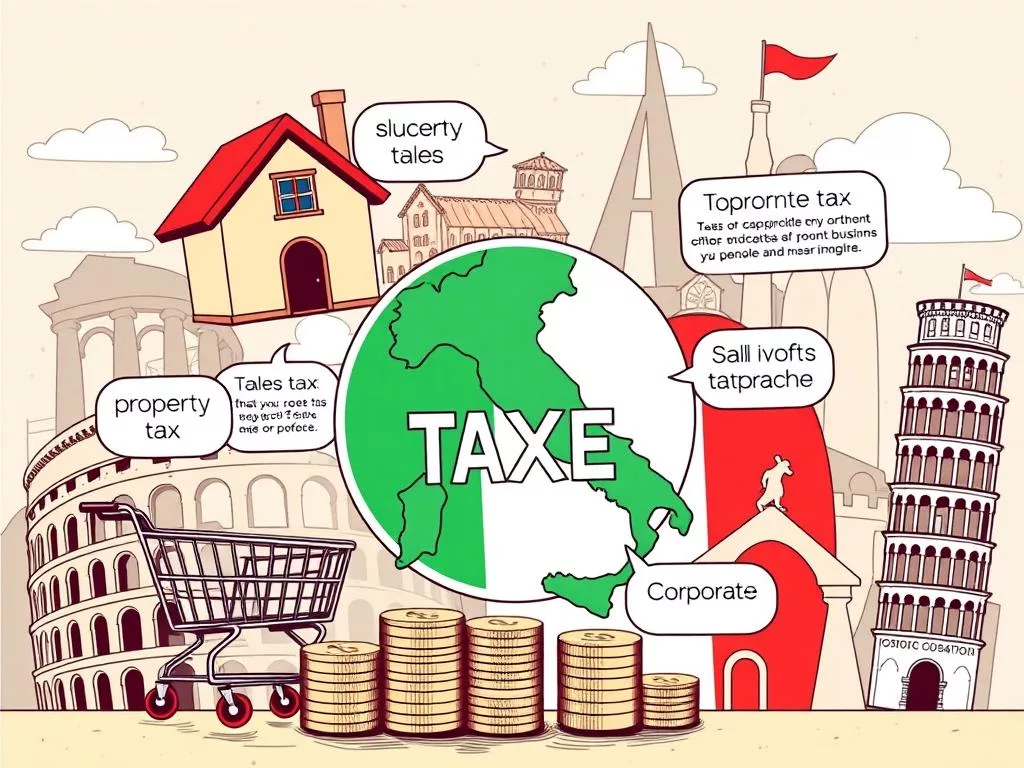Exploring the Italian tax system can be tricky for both locals and visitors. This Italy tax guide helps clarify how personal income tax (PIT), or Imposta sui redditi delle persone fisiche (IRPEF), affects those earning in Italy. With over 58 million people, Italy’s tax rates are based on how much you make, making sure everyone pays fairly.
There’s a special focus on extra taxes for those in the financial world. For the more than 15,000 US expats in Italy, the expat taxes in Italy section is key. It explains who can get Italy’s special flat tax, making taxes simpler for non-Italian income. This guide is a must-read for anyone wanting to grasp Italian tax rates and rules.
The standard Italian tax system includes regional production tax rates (IRAP) from 3.9% to 4.82%. There’s also a 22% standard value-added tax rate. Plus, there are taxes on wealth, like properties and investments outside Italy, at 0.76% and 0.2%, respectively. Knowing these details can make financial planning in Italy easier, ensuring you follow local tax laws.
Types of Taxes in Italy
Italy has different taxes at national, regional, and municipal levels. It’s important for both locals and foreigners to know about these taxes. The national income tax in Italy goes up as your income does. It starts at 23% for income up to €28,000, then 27% for income between €28,001 and €50,000, and 43% for more than €50,001.
Regional income taxes vary from 1.23% to 3.33%, depending on where you live. Municipal income tax also changes, usually between 0% and 0.9%. Where you live greatly affects how much you pay in taxes.

There are also taxes on wealth, like the property tax. This tax can be between 2% and 9% of the property’s price. If you have more than one property, the rate goes up to 9%. All money you get from work, including bonuses, is also taxed.
Italy taxes everyone on their worldwide income if they live there. But, if you don’t live there, you only pay taxes on income made in Italy. Knowing this is key to understanding your taxes.
Italy has a special tax deal for new residents. If you move there and pay a certain amount, you get a flat tax of €100,000. Each family member gets an extra €25,000 for income not from Italy. This deal is great for wealthy people who move to Italy.
- Individuals in Italy face a variety of taxes depending on their income and wealth.
- Regional income tax Italy rates vary significantly, influencing overall tax liabilities.
- The municipal income tax Italy is another essential aspect, determined by the local municipalities.
Businesses in Italy pay a corporate income tax of 24%. They also have to pay the regional production tax (IRAP), which is between 3.9% and 5.9%. Taxes on real estate are based on the property’s value in the land registry.
| Type of Tax | Rates/Details |
|---|---|
| National Income Tax | Progressive: 23%, 27%, 43% |
| Regional Income Tax | 1.23% to 3.33% |
| Municipal Income Tax | 0% to 0.9% |
| Corporate Income Tax | 24% |
| Flat Substitutive Tax for New Residents | €100,000 + €25,000 per family member |
Guide to Taxes in Italy
Filing taxes in Italy can be tough for both locals and visitors. Knowing what taxes you owe is key to following the rules and planning your taxes well.
Who pays taxes in Italy depends on where you live. For example, in 2024, the tax rates are set up like this:
| Income Range | Tax Rate |
|---|---|
| Up to €28,000 | 23% |
| €28,001–55,000 | 35% |
| €55,001 and above | 43% |
Municipal taxes are usually less than 1%. Regional taxes vary from 1.2% to 3.3%, based on where you live.

Using the Public Digital Identity System (SPID) makes filing easier. It lets you see your tax form before you fill it out. Employees and retirees must file Form 730 by September 30 of the next year. Others file with Form REDDITI PF by October 31. If you’re not living in Italy, you have until November 30 to file from abroad.
In 2023, Italy started taxing cryptocurrency trades at 26% on profits over €2,000. This is something to think about for those trading cryptocurrencies.
Italy and the US have a tax treaty to avoid taxing the same income twice. This treaty helps those moving to Italy after retirement. It gives a 7% tax rate on foreign income for ten years. Also, those with a lot of money moving to Italy under a special tax rule pay a flat tax of €100,000. For more on offshore banking and taxes, check out this guide.
Rental income in Italy is taxed at 21% under a special scheme. But, you can’t deduct anything. You can file online or by mail to the Revenue Agency in Venice.
For Americans in Italy, knowing these tax rules helps you manage your taxes better.
Special Tax Regimes and Exemptions for Expats
Italy offers special tax regimes and exemptions to attract foreign professionals and retirees. The flat tax regime Italy lets new residents pay a fixed annual tax of €100,000 on foreign income. This makes it simpler and reduces the tax on foreign earnings.
To qualify, you must not have been a tax resident in Italy for nine out of ten years. This rule helps those moving to Italy save on taxes. It also benefits family members, who pay a €25,000 fixed tax on their foreign income. This makes Italy a great choice for expats looking to save money.
Expats can also get a 50-60% tax cut on Italian income for up to five years. Retirees in some areas pay just 7% on foreign income. There are also no taxes on inheritance and gifts from abroad. Italy’s low capital gains tax and reduced property taxes make it a smart choice for new residents. For more information, visit Taxes for Expats.
Italy’s tax benefits, along with its culture and quality of life, make it an attractive place for expats. If you’re thinking about moving to Italy, knowing the rules and application process is key to getting the most tax benefits.

